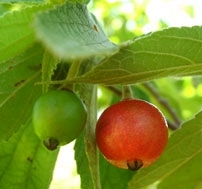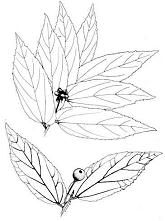ISLAND CONSERVATION-Delicious but invasive – the Jamaican cherry |11 August 2008

He had recognised it as a species of tree that was common in Maldives and often took his two children on fruit-collecting expeditions when they went for walks at Roche Caïman. The 
My curiosity was aroused, but with the pressures of work and various extra-professional activities the matter slipped my mind somewhat.
I was reminded of the mysterious tree in 1996 when Justin Gerlach of the Nature Protection Trust of Seychelles (NPTS) published a note in the journal Phelsuma. It was about a new plant, the “Jamaican cherry”, that had been observed for the first time in Seychelles in 1990, when it colonised the reclamation on the east coast of Mahe. In 1993 a specimen from the Roche Caïman bird sanctuary had been identified as this species – Muntingia calabura to botanists.
I rushed to my library and started pulling out my plant books. I scanned the pages, comparing descriptions. On page 644 of my 1952 edition of Wayside Trees of Malaya I found one that was fairly detailed but at the same time not too technical: “…dense, spreading crown, the branches drooping; bark smooth, pale brownish grey, tough, fibrous; twigs and leaves hairy and sticky.
Leaf-blade narrowly ovate, broadest near the asymmetric base; white petals; fruit a berry, pink then red, the tiny yellow seeds embedded in a sweet pulp…The sweet berries are much sought after by children and, also, by birds and animals…”
The tree that Ibrahim had found had to be this, the Jamaican cherry! The scientific name Muntingia, I read, was derived from the name of the 17th-century Dutch botanist Abraham Munting.

To taste or not to taste? Both Gérard and I hesitated, but I thought he was even more apprehensive than I was. “Je ne peux plus me retenir,” I said finally, squeezing one of the berries slightly between my fingers. “Il faut absolument que j’y goûte.”
I popped it into my mouth. The exquisite fruity caramel-like taste that washed over my taste buds, backed by the crunchiness of the tiny seeds, was almost startling. Ibrahim had not been exaggerating! No wonder one old French book, published in 1835, had said about the fruits: “Ils sont très recherchés par les jeunes Créoles, qui leur trouvent un goût agréable; on les sert même sur les tables.”
The author was referring to the inhabitants of the West Indies, because the Jamaican cherry is a native of Central and South America and the Caribbean – hence its common name. It was among the exotic fruits that the Spanish conquistadores discovered when they invaded what is now “Latin” America in the 16th century.
That is when the plant, in turn, set about conquering the tropical world. The Spaniards introduced it to the Philippines after that territory became a Spanish colony in 1571. It was only a matter of time before it was taken to other islands in the Pacific and various parts of south-east Asia, where it was cultivated for its tasty berries.
During the “Battle of Opium Hill” in Singapore during the second world war, soldiers of the Imperial Japanese Army caught the wounded platoon leader of the 1st Malay Regiment, Lieutenant Adnan bin Saidi, tied him to a Jamaican cherry tree and bayoneted him to death. By then Muntingia had already reached Sri Lanka, Maldives, tropical Australia, even Christmas and Cocos islands east of Seychelles in the Indian Ocean. People were not the only ones propagating it: birds, bats and monkeys found the luscious berries irresistible – and were dispersing the seeds in the wild.
Today the Jamaican cherry is one of the plants on the ever-growing list of dangerous invasive species all over the Pacific. It grows so rapidly in well-drained soils in open, sunny areas that within 18 months after germinating it can reach a height of at least 3 metres and start to flower. The “semences nombreuses (hundreds actually, each one half a millimetre long) nichées dans une pulpe” are not only spread in the droppings of birds, bats and other animals but are also washed further afield by rainfall runoff. In a study on Christmas Island, nine out of every 10 seeds found in the top 3cm of soil were Muntingia seeds.
Rapid growth, early reproductive maturity, high fecundity – the classic textbook characteristics of what biologists call “colonising species”, the ones that invade large empty areas. The tree is also reputed to be able to send out suckers from its roots. Mercifully, it does die back if it is shaded by surrounding vegetation, and the seeds germinate only if there is enough light.
We do not know how the Jamaican cherry got to Seychelles. But it is still around in spite of earlier speculation that “this introduction will probably prove to be temporary”. Last year I discovered a tree growing outside a house at Hermitage. I noticed that it was bearing fruit and wondered if the owners of the house knew what it was.
Walking past earlier this year I overheard a young woman standing at the doorway tell a nurse from nearby Victoria hospital who was standing on the main road: “I don’t know what it is. But I saw birds eating the fruit, so I tried tasting them as well. They are so delicious! I pick and eat them all the time now.”
Then two Saturdays ago I was visiting a friend at Plaisance when I heard the loud squawk of a bulbul. I turned to see what the bird was up to. It was an immature merl, perched on the branch of a Jamaican cherry tree growing next to the disused St Agnes’ chapel. There were dozens of fruits among the foliage, but they were all still green. The bulbul seemed to peer at them and then, no doubt disappointed, let out another plaintive cry and flew away.
by Pat Matyot




